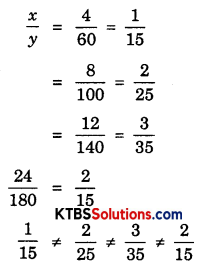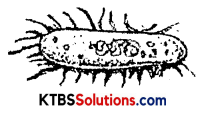You can Download KSEEB Solutions for Class 8 Maths Chapter 13 Direct and Inverse Proportions Ex 13.1 Questions and Answers helps you to revise the complete syllabus.
KSEEB Solutions for Class 8 Maths Chapter 13 Direct and Inverse Proportions Ex 13.1
Question 1.
Following are the car parking charges near a railway station upto
4 hours – Rs. 60
8 hours – Rs. 100
12 hours – Rs. 140
24 hours – Rs. 180
Check if the parking charges are in direct proportion to the parking time.
Solution:
Let parking time of a car x hours and its charges in Rs. is y.

The charges are directly proportional
if \(\frac{x}{y}\) = constant

No, the parking charge is not directly proportional to parking time.
![]()
Question 2.
A mixture of paint is prepared by mixing 1 part of red pigments with 8 parts of the base. In the following table, find the parts of the base that need to be added.

Solution:
Let the parts of red pigment x and part of base y.
Since these are directly proportional.
\(\frac{x}{y}=\frac{1}{8}=\frac{1 \times 4}{8 \times 4}=\frac{4}{32}\)
= \(\frac{1 \times 7}{8 \times 7}=\frac{7}{56}\)
= \(\frac{1 \times 12}{8 \times 12}=\frac{12}{96}\)
= \(\frac{1 \times 20}{8 \times 20}=\frac{20}{160}\)

Question 3.
In Question 2 above, if 1 part of a red pigment requires 75 ml of the base, how much red pigment should we mix with 1800 ml of the base?
Solution:
Let red pigment = x
Part of base = y
Since the ratio are directly proportional
\(\frac{x}{y}=\frac{1}{75}\)
⇒ \(\frac{1}{75}=\frac{x}{1800}\)
⇒ x = \(\frac{1800}{75}\)
⇒ x = 24

![]()
Question 4.
A machine in a soft drink factory fills 840 bottles in six hours. How many bottles will it fill in five hours?
Solution:

Since the relation of No. of bottles and filling time is directly proportional.
\(\frac{840}{6}=\frac{x}{5}\)
x = \(\frac{840 \times 5}{6}\)
x = 700
∴ No. of bottles = 700
Question 5.
A photograph of a bacteria enlarged 50,000 times attains a length of 5 cm as shown in the diagram. What is the actual length of the bacteria? If the photograph is enlarged 20,000 times only, what would be its enlarged length?

Solution:
Since the length of bacteria and its enlargement times are directly proportional.
\(\frac{50000}{5}=\frac{20000}{x}=\frac{1}{x_{1}}\)
x = \(\frac{5 \times 20,000}{50,000}\) = 2
x1 = \(\frac{5}{50,000}=\frac{1}{10,000}\) = 0.0001

![]()
Question 6.
In a model of a ship, the mast is 9 cm high, while the mast of the actual ship is 12 m high. If the length of the ship is 28 m, how long is the model ship?

Solution:

Height of mast of model ship to that of actual ship varies directly.
\(\frac{9}{12}=\frac{x}{28}\)
x = \(\frac{9 \times 28}{12}\)
x = 21
Height of mast of model ship = 21 cm
Question 7.
Suppose 2 kg of sugar contains 9 x 106 crystals. How many sugar crystals are there in
(i) 5 kg of sugar?
(ii) 1.2 kg of sugar?
Solution:

Since the wt. of sugar and number of crystals are directly propotional.
\(\frac{2}{9 \times 10^{6}}=\frac{5}{x}=\frac{1.2}{y}\)
x = \(\frac{5 \times 9 \times 10^{6}}{2}\)
= 22.5 × 106
= 2.25 × 10 × 106
= 2.25 × 107
y = \(\frac{1.2 \times 9 \times 10^{6}}{2}\)
y = 0.6 × 9 × 106
= 5.4 × 106
![]()
Question 8.
Rashmi has a road map with a scale of 1 cm representing 18 km. She drives on a road for 72 km. What would be her distance covered in the map?
Solution:

The scale representing the actual distance on map is directly propotional.
\(\frac{1}{18}=\frac{x}{72}\)
x = \(\frac{72}{18}\) = 4
Question 9.
A 5m 60 cm high vertical pole casts a shadow 3m 20 cm long. Find at the same time
(i) the length of the shadow cast by another pole 10 m 50 cm high
(ii) the height of a pole which casts a shadow 5 m long.
Solution:

Since height of pole and length of shadow are directly proportional
\(\frac{560}{320}=\frac{1050}{x}=\frac{y}{500}\)
⇒ x = \(\frac{1050 \times 320}{560}\)
⇒ x = 600 cm
\(\frac{1050}{600}=\frac{y}{500}\)
⇒ y = \(\frac{1050 \times 500}{600}\)
⇒ y = 875
![]()
Question 10.
A loaded truck travels 14 km in 25 minutes. If the speed remains the same, how far can it travel in 5 hours?
Solution:

Since the distance travelled and time take are directly proportional.
\(\frac{14}{\frac{5}{12}}=\frac{x}{5}\)
\(\frac{14 \times 12}{5}=\frac{x}{5}\)
x = \(\frac{14 \times 12 \times 5}{5}\)
x = 168
∴ Distance travelled = 168 km.